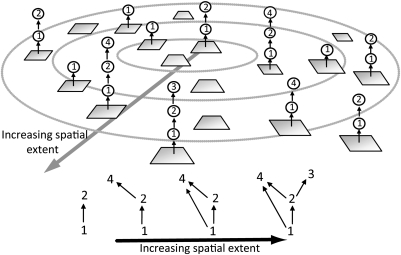Fig. 1.
A simple example of how food web complexity might emerge at large spatial scales through the spatial aggregation of local food chain networks with increasing spatial extent within a metacommunity. (Upper) Numerous local habitat patches, represented by squares, contain various local food chains. The concentric circles show different sample sizes, and the large arrow shows the direction of increasing spatial extent. As spatial scale increases, and as more species and potential feeding interactions are sampled, the observed trophic complexity of the regionally aggregated food web [depicted by the network diagrams (Lower)] increases despite the complexity within local patches being constrained to simple network configurations—in this case, simple food chains. (Lower) The observed regional food web networks that correspond to increasing spatial extent. In this paper we assume complete competitive exclusion of inferior competitors from a given resource within patches, such that the only way two species that potentially feed on a common resource can coexist within a patch (e.g., species 2 and 4 competing for species 1) is if one species is an omnivore capable of switching its feeding to another species in the local food chain, as when species 4 switches its feeding predominantly toward species 2 when 2 excludes 4 from resource species 1.

